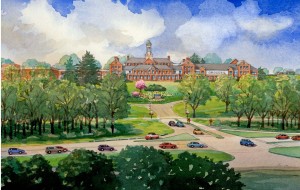A proposed retail center on the former Reader”™s Digest campus would not draw business away from nearby hamlet shopping districts, a consultant to New Castle”™s Town Board recently reported.
A study prepared by AKRF Inc. said the anchor grocery store and retail shops proposed by the developer of Chappaqua Crossing could bring more customers and sales to businesses in the hamlets of Chappaqua and Millwood.

Summit/Greenfield, the Connecticut-based partnership that owns Chappaqua Crossing, is seeking town approvals to develop 120,000 square feet of retail space on the office campus. It would include a grocery store with 36,000 square feet to 66,000 square feet of space in the iconic Reader”™s Digest headquarters building and several new retail stores.
Summit/Greenfield this year hired HR&A Advisors Inc., a real estate development consulting firm in New York City, to conduct an environmental impact study at Chappaqua Crossing. New Castle officials later commissioned their own study to assess the proposed retail development”™s impact on existing businesses in the hamlets.
The conclusions AKRF drew in its recent study mirror the findings of Summit/Greenfield”™s consultant, a spokesman for the developer said.
“There”™s a significant outflow of spending from the town of New Castle to other communities because New Castle doesn”™t have a supermarket in town,” said Chappaqua Crossing spokesman Geoffrey Thompson. “You have a small A&P in Millwood but nothing in Chappaqua. Think about how many people go to the supermarket every day. That”™s taking a lot of people out of town.”
Chappaqua”™s D”™Agostino Supermarket closed in 2011.
The town”™s consultant found consumer expenditures are already “leaking” from the hamlets to neighboring communities such as Mount Kisco, Pleasantville and Ossining because the hamlets don”™t have an anchor grocery store.
AKRF said a grocery store at Chappaqua Crossing would draw customers within a 10-mile radius and could bring significantly more traffic to the Chappaqua and Millwood shopping districts than the hamlets can alone. Local shopping areas typically rely on trade from residents within a one-mile radius.
A Chappaqua Crossing grocery would compete largely with other large-format grocery stores outside the community, the consultant said.
The town board is setting parameters that make it impossible to put in very small stores that would compete with the retail businesses in the hamlets, Thompson said.
“That”™s one of their ways of controlling the retail that goes there, to keep the stores at Chappaqua Crossing from undermining and being similar to stores in the hamlets in terms of size,” he said.
To keep out competition from big-box national retail chains and small boutiques, AKRF recommended limiting retail space for Chappaqua Crossing tenants to between 54,000 square feet and 84,000 square feet.
In its June business survey, the town consultant counted 120 retail stores that occupy 220,800 square feet of space within the two hamlets. The average store in Chappaqua and Millwood occupies 1,840 square feet of space.
About 38 hamlet retailers serve personal and laundry needs, including 14 hair and beauty salons, seven nail salons, two day spas, nine dry cleaners and two fitness centers. Personal and laundry needs make up the majority of businesses in both hamlets.
The survey found 23 bars and restaurants and 13 clothing and accessories shops within the shopping districts.
AKRF looked at two design concepts proposed for retail development at Chappaqua Crossing. Though both design layouts would create potential competition for local retailers, the consultant said the Town Center model would more directly compete with the hamlet business districts.
“There would be some retail overlap with either layout,” AKRF reported. But the Town Center layout would “compete for residents”™ leisure time, as it would provide open space and other amenities that would draw users to the space and promote lingering.”
Although the Chappaqua Crossing proposal faces heavy opposition from some New Castle businesses and residents, the town supervisor said the project will be an asset for the community that will provide a substantial commercial tax base.
“The board wanted to retain the potential for commercial development on the site of Reader”™s Digest, meaning not tearing it down but rebuilding it,” said Town Supervisor Susan Carpenter. “The town has been making sure those buildings are redeveloped for commercial use…I don”™t think anybody changed their mind about that.”





















